Roseville:
America's Decorative Art Pottery
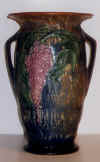 One Day Exhibit of Roseville Art
Pottery
One Day Exhibit of Roseville Art
Pottery How often can you see great examples of all the major lines made by the Roseville Pottery? You may see a few pieces in antique malls, and a few more at pottery shows, but most of us never have the opportunity to see the entire range of Roseville’s production all at once. The Wisconsin Pottery Association (WPA) will provide this rare opportunity in a comprehensive showing of this popular Art Pottery at its August 28, 1999 Exhibit: Roseville: America’s Decorative Art Pottery.
On display will be over 300 examples of Roseville
pottery, representing about 140 of  the best lines produced during the company’s
63 year history. As if that’s not enough, the Exhibit will include special
displays on topics of interest to old and new Roseville collectors alike. And,
as with past WPA Exhibits, Roseville: America’s Decorative Art Pottery
will be held along with the WPA’s annual Pottery Show and Sale where over 75
pottery dealers will sell every type of antique and collectible pottery.
the best lines produced during the company’s
63 year history. As if that’s not enough, the Exhibit will include special
displays on topics of interest to old and new Roseville collectors alike. And,
as with past WPA Exhibits, Roseville: America’s Decorative Art Pottery
will be held along with the WPA’s annual Pottery Show and Sale where over 75
pottery dealers will sell every type of antique and collectible pottery.
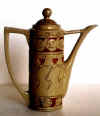 The Roseville Pottery began producing utilitarian
earthenware in Roseville, Ohio in 1890. Over the next decade, it purchased
factories in nearby Zanesville where production of Art Pottery began around 1900
with the Rozane line. Under the artistic direction of the English potter
Frederick H. Rhead, the firm produced several great Art Pottery lines including Della
Robbia, Mongol, Egypto, Woodland, Olympic, Fudji, Azurean, and
others. Examples of these seldom-seen lines, as well as samples of the early
utility ware, will open this year’s Exhibit. By 1910, the Roseville Pottery
relocated its entire operation to Zanesville, where production increasingly
turned to molded ware with raised (embossed) patterns. These served as templates
for hand painted decoration of the pottery. This technique allowed
The Roseville Pottery began producing utilitarian
earthenware in Roseville, Ohio in 1890. Over the next decade, it purchased
factories in nearby Zanesville where production of Art Pottery began around 1900
with the Rozane line. Under the artistic direction of the English potter
Frederick H. Rhead, the firm produced several great Art Pottery lines including Della
Robbia, Mongol, Egypto, Woodland, Olympic, Fudji, Azurean, and
others. Examples of these seldom-seen lines, as well as samples of the early
utility ware, will open this year’s Exhibit. By 1910, the Roseville Pottery
relocated its entire operation to Zanesville, where production increasingly
turned to molded ware with raised (embossed) patterns. These served as templates
for hand painted decoration of the pottery. This technique allowed less-skilled
artisans to decorate more pieces, which increased the amount of ware produced,
and profits. Frank Ferrell created the Roseville pottery that is most familiar
and popular to antique lovers today. A Zanesville native and artist at several
area potteries, he became Roseville’s art director in 1918, and continued in
that position until the plant closed in 1953. Ferrell designed all of Roseville’s
Art Pottery during this period, about 90 lines in all. Ferrell sculpted the
embossed patterns, designed thousands of shapes, and chose the colors based on
ceramic engineer George Krause’s beautiful and durable matt glazes. Frank
Ferrell’s 35 year legacy at Roseville will form a major part of Roseville:
America’s Decorative Art Pottery.
less-skilled
artisans to decorate more pieces, which increased the amount of ware produced,
and profits. Frank Ferrell created the Roseville pottery that is most familiar
and popular to antique lovers today. A Zanesville native and artist at several
area potteries, he became Roseville’s art director in 1918, and continued in
that position until the plant closed in 1953. Ferrell designed all of Roseville’s
Art Pottery during this period, about 90 lines in all. Ferrell sculpted the
embossed patterns, designed thousands of shapes, and chose the colors based on
ceramic engineer George Krause’s beautiful and durable matt glazes. Frank
Ferrell’s 35 year legacy at Roseville will form a major part of Roseville:
America’s Decorative Art Pottery.
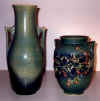 One of the special displays within the
Exhibit will feature Roseville experimental vases. Almost all of the
"Roseville experimentals" for sale at antique malls or on the internet
are imposters. Many are routine production items from other potteries, while
others may have been cast from Roseville pieces by unknown makers. Genuine
Roseville experimentals differ in several ways from ordinary production pottery:
the raised patterns were hand-sculpted rather than produced from a mold, most
were done on four basic shapes, many had notes and information etched on the
blank side, and as such they were either one-of-a-kind, or very limited in
number. Ferrell created these experimentals to assess their potential in
concrete form. Some patterns were selected for mass production, others were not.
One of the special displays within the
Exhibit will feature Roseville experimental vases. Almost all of the
"Roseville experimentals" for sale at antique malls or on the internet
are imposters. Many are routine production items from other potteries, while
others may have been cast from Roseville pieces by unknown makers. Genuine
Roseville experimentals differ in several ways from ordinary production pottery:
the raised patterns were hand-sculpted rather than produced from a mold, most
were done on four basic shapes, many had notes and information etched on the
blank side, and as such they were either one-of-a-kind, or very limited in
number. Ferrell created these experimentals to assess their potential in
concrete form. Some patterns were selected for mass production, others were not.
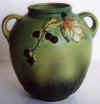 While these rare items occasionally turn up for
sale at Art Pottery shows, most are already in the hands of collectors. But it
does pay to know the difference. A few years ago, two genuine Roseville
experimentals were purchased for under $75 at a rural Wisconsin flea market. It
remains a mystery how they got there. A selection of Roseville experimentals and
trial glaze vases will be included in the Exhibit, along with some common imposters.
While these rare items occasionally turn up for
sale at Art Pottery shows, most are already in the hands of collectors. But it
does pay to know the difference. A few years ago, two genuine Roseville
experimentals were purchased for under $75 at a rural Wisconsin flea market. It
remains a mystery how they got there. A selection of Roseville experimentals and
trial glaze vases will be included in the Exhibit, along with some common imposters.
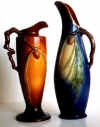 One of Frank Ferrell’s greatest creations for Roseville was the Pine
Cone line. Introduced in the early 1930s in rich blue, golden brown, and
soft green glazes, it was the company’s best-selling line, and may have saved
the firm from bankruptcy during the Depression, just as the Donatello
pattern reversed the company’s fortunes in 1915. Over 150 Pine Cone
shapes were created, the largest number of forms in any Roseville line. A common
misconception among beginning collectors is that Roseville lines were produced
for one year only; in fact, the company continued making a line, and even adding
new forms to it, until sales declined. The Pine Cone line is
One of Frank Ferrell’s greatest creations for Roseville was the Pine
Cone line. Introduced in the early 1930s in rich blue, golden brown, and
soft green glazes, it was the company’s best-selling line, and may have saved
the firm from bankruptcy during the Depression, just as the Donatello
pattern reversed the company’s fortunes in 1915. Over 150 Pine Cone
shapes were created, the largest number of forms in any Roseville line. A common
misconception among beginning collectors is that Roseville lines were produced
for one year only; in fact, the company continued making a line, and even adding
new forms to it, until sales declined. The Pine Cone line is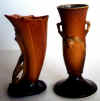 a good
example of this. Pine Cone forms can be found unmarked (they probably had
the silver or gold paper label used in the early 1930s), with an impressed mark,
and, most commonly, with the raised script mark that was used from 1937 until
1953. This may be evidence that
a good
example of this. Pine Cone forms can be found unmarked (they probably had
the silver or gold paper label used in the early 1930s), with an impressed mark,
and, most commonly, with the raised script mark that was used from 1937 until
1953. This may be evidence that 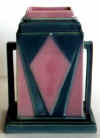 new Pine Cone forms were continually
being added to the line. Furthermore, the obvious stylistic and glaze
differences in the Pine Cone "400 series" (shapes with
raised script numbers in the 400s) may indicate that Ferrell revisited the line
in the late 1940s or early 1950s, updating or replacing some of the earlier
shapes with the sleeker, modernistic style of the period. The Roseville Exhibit
will include special displays of Pine Cone and Futura, two of
Ferrell’s most popular Roseville lines.
new Pine Cone forms were continually
being added to the line. Furthermore, the obvious stylistic and glaze
differences in the Pine Cone "400 series" (shapes with
raised script numbers in the 400s) may indicate that Ferrell revisited the line
in the late 1940s or early 1950s, updating or replacing some of the earlier
shapes with the sleeker, modernistic style of the period. The Roseville Exhibit
will include special displays of Pine Cone and Futura, two of
Ferrell’s most popular Roseville lines.
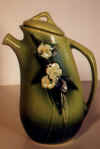 Roseville authors Nancy Bomm and Mark Bassett are
scheduled to attend the Exhibit and sell at the Show where they will be
available to chat with the public about their books and Roseville pottery. Mrs.
Bomm and her late husband Jack wrote Roseville In All Its
Splendor, an extremely useful, informative, and complete guide to the Roseville
Pottery. This 1998 book is essential to anyone who wants to understand the
breadth and beauty of Roseville’s work. Mr. Bassett’s book Introducing
Roseville Pottery has just been published. His research documents
previously unknown Roseville products, revises some of the dates commonly
attributed to Roseville lines, and promises a new approach and perspective for
Roseville collectors. Roseville: America’s
Decorative Art Pottery will also include
information on how to identify Roseville, how to tell the difference between
Roseville and common look-a-likes (including the Chinese reproductions currently
on the market), the company’s history, how to value Roseville, and other
interesting odds and ends about Roseville and the people who made it. But most
of all, there will be hundreds of beautiful and rare Roseville pots to see,
tangible proof of the breadth and brilliance of the Roseville Pottery’s
amazing legacy. This will be the Wisconsin Pottery Association’s fourth
all-Pottery Show/Sale, and its fourth Exhibit of American Art Pottery.
Roseville authors Nancy Bomm and Mark Bassett are
scheduled to attend the Exhibit and sell at the Show where they will be
available to chat with the public about their books and Roseville pottery. Mrs.
Bomm and her late husband Jack wrote Roseville In All Its
Splendor, an extremely useful, informative, and complete guide to the Roseville
Pottery. This 1998 book is essential to anyone who wants to understand the
breadth and beauty of Roseville’s work. Mr. Bassett’s book Introducing
Roseville Pottery has just been published. His research documents
previously unknown Roseville products, revises some of the dates commonly
attributed to Roseville lines, and promises a new approach and perspective for
Roseville collectors. Roseville: America’s
Decorative Art Pottery will also include
information on how to identify Roseville, how to tell the difference between
Roseville and common look-a-likes (including the Chinese reproductions currently
on the market), the company’s history, how to value Roseville, and other
interesting odds and ends about Roseville and the people who made it. But most
of all, there will be hundreds of beautiful and rare Roseville pots to see,
tangible proof of the breadth and brilliance of the Roseville Pottery’s
amazing legacy. This will be the Wisconsin Pottery Association’s fourth
all-Pottery Show/Sale, and its fourth Exhibit of American Art Pottery.
Click here
for a detailed description of pottery shown.
Click here for the original press release.
P.O. Box 46, Madison WI 53701 |
|